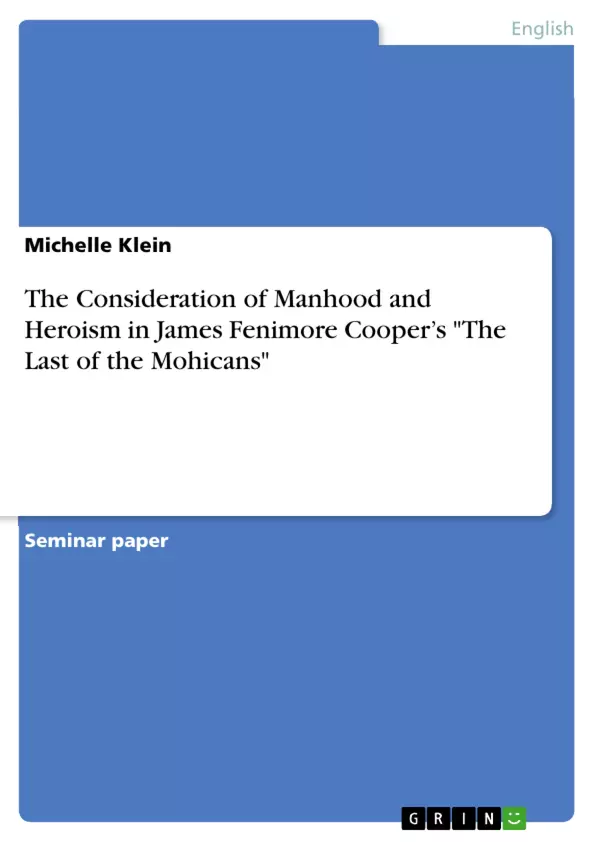The frame story of the novel The Last of the Mohicans written by James Fenimore Cooper in 1826, deals with two young British ladies, Alice and Cora, on their journey to their father Colonel Munro. The story is set in North America in 1759 during the war between the French and British colonists who fight for their territories. The two women are escorted by Major Duncan Heyward, a confidant of Colonel Munro, by Hawkeye, a white man who is allied with the Mohicans, and his Mohican friends Uncas and his father Chingachgook. On their journey they encounter various dangers which are largely due to the Hurons,an Indian tribe that is allied with the French. Therefore, the male characters have to show their abilities in fighting and protecting themselves, as well as the females, throughout the story.
Cooper approaches several topics in the narrative like racism, colonialism, heroism and masculinity but, I will only refer to the latter two. This paper reveals the differences and similarities between the characters Hawkeye, Uncas and Heyward by analysing their outer appearance and behaviour in order to review their heroism and manhood. All those three protagonists possess abilities which could allow them to be the novel’s hero. But only Major Duncan Heyward goes through an outstanding personal development and therefore, meets the requested characteristics of a hero by the end of the story best.
The first character that undergoes analysis is Hawkeye. I will have a closer look at his hybrid identity as he is a white man who lives in the ‘wilderness’. Furthermore, his role in the narrative is discussed to classify his importance for the story. The character that is argued next is the Indian warrior Uncas. Considering his fate to be the last of the Mohicans and his secret love to Cora, his heroic position gets explained. Heyward, analysed lastly, is presented before and after living in the woods. It is demonstrated why he can be seen as the story’s hero. Finally, the conclusion contains the comparison of the three characters and makes clear why Duncan unites all required features to obtain the status of the hero.
Table of Contents
- Introduction
- Hawkeye - The Man with a Hybrid Identity
- Uncas - The Last of the Mohicans
- Duncan Heyward - The Hero of the Novel
- Conclusion
Objectives and Key Themes
This paper analyzes the characters of Hawkeye, Uncas, and Heyward in James Fenimore Cooper's The Last of the Mohicans to examine their heroism and masculinity. The paper explores the differences and similarities between these characters through their appearance and behavior. It also investigates the concept of heroism in the context of the novel's setting and themes.
- Hybridity and Cultural Identity
- Heroism and Masculinity in the Wilderness
- The Role of Native American Culture in Colonial America
- The Conflict Between Civilization and Nature
- The Impact of Racial Prejudice and Colonialism
Chapter Summaries
The introduction sets the scene for the analysis, introducing the main characters and the context of the novel. It also establishes the focus on heroism and masculinity.
The first chapter examines Hawkeye's hybrid identity as a white man living among Native Americans. It analyzes his appearance, behavior, and his role as a guide and protector in the story.
The second chapter focuses on Uncas, the last of the Mohicans, and his heroic qualities. It explores his appearance, his relationship with Cora, and his fate in the novel.
The third chapter analyzes Duncan Heyward, examining his transformation from a civilized gentleman to a more rugged and resourceful individual in the wilderness. It explores his heroism and how he ultimately fulfills the requirements of a hero.
Keywords
The key terms and concepts explored in this analysis include: hybrid identity, heroism, masculinity, Native American culture, colonialism, civilization, wilderness, and racial prejudice.
- Quote paper
- Michelle Klein (Author), 2015, The Consideration of Manhood and Heroism in James Fenimore Cooper’s "The Last of the Mohicans", Munich, GRIN Verlag, https://www.grin.com/document/337804



